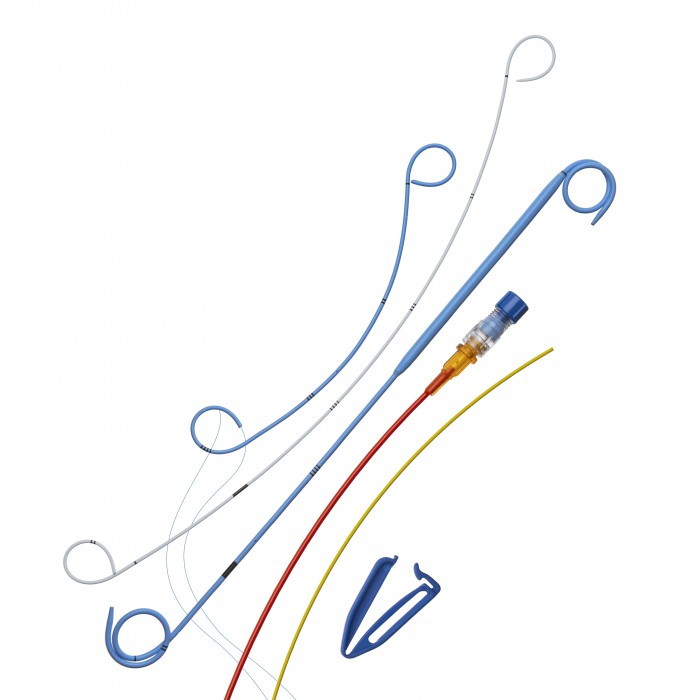Double Loop Ureteral Stents
Uretral stents are used for temporary internal drainage from the renal pelvis to the bladder. Invumed Innovations provides an extensive range of ureteral stents with different tip configurations, hydrophilic coating and proprietary materials.
- Invumed uretral stents are made of polyurethane: Tecoflex for the short term and Carbothane for long term use. The products are biocompatible even for long-standing use.
- Our cross-sectional design feature decreases the liability to compression.
- All stents are memory free.
- Colour coding: blue for Tecoflex and white for Carbothane.
- Hydrophilic coating: available option to improve stent application, decrease incident of associated infection and prolong life of the stent.
Catheters for urodynamic testing
Urodynamic catheter is used to estimate changes that occur inside the bladder and or the urethra during filling or voiding. Invumed offers cystometry and UPP sets comprising bladder pressure and filling catheters or bladder filling and rectal catheters in one pack.
- Pruduces of radiopaque polyurethane, biocompatible material with high mechanical features.
- In general the catheter has length 40 cm and the rectal catheter has length 30 cm.
- Pigtail 2 lumen cystometry is also available for secure positioning inside the bladder.
- All catheters offers 1cm and 5cm interval depth markings.
- Catheters are fitted with male Luer color-coded connectors.
Uretral access sheaths
Used to establish a conduit during endoscopic urological procedures, thereby facilitating the passage of endoscopes and other instruments into the urinary tract.
- Reduce the pressure in kidney and reduce the risk of sepsis.
- Hydrophilic coating on external sheath and dilator for easy insertion.
- Kink resistant sheath is reinforced with a stainless steel coil.
- Smooth step between access sheath & dilator.
- Radiopaque Marker Band designed to facilitate placement of sheath tip under fluoroscopy.
- Funneled luer end for easy hand grip and suitability to fix in position.
- Full range: inner diameter 11-14Fr, length 14-55cm.
Suprapubic Cystostomy Catheter Kits
Invumed offers wide range of suprapubic cystostomy catheter kits based on metallic or plastic splitable cannulas supplied with different types of polyurethane catheters or two ways foley catheters.
- The kits comes with metallic or plastic splittable cannula.
- The kit contains either: polyurethane single lumen catheter with J or malecot tip with a metallic straightner inside, or 2 way latex or silicone balloon catheter.
- The kit contains all accessories that facilitate easy insertion and post operative closed system drainage.
- Single-use, supplied sterile in a single blister.
Percutaneous Nephrostomy Sets
Invumed offers a complete catheter sets based on Malecot or Pigtail drainage catheters.
- A complete kits for percutaneous placement of drainage catheter – Pigtail design, Malecote design, Re-entry nephrostomy catheter, Pigtail with String lock.
- All catheters are single lumen, for adult or pediatric use, 4-24 Fr diameter sizes and 30 cm length.
- Catheters are made with soft polyurethane and provides superior biocompatibility and drainage.
- Catheters highly radiopaque for precise placement.
- All sets supplied with the necessary and optional items: dilatators, needles, J-tip nitinol guide wire, drainage bag connector.
- Individually packed in medical grade paper poly pouch.
Nephrostomy balloon dilator sets
Is also known as a nephrotic balloon dilator. Used to dilate the musculofascial tract and renal capsule establishing a Nephrostomy tract during a percutaneous procedure.
- Designed to maintain 30 Fr diameter under high pressure.
- Designed to provide effective, uniform dilation along the nephrostomy tract.
- Includes firm amplatz renal sheath.
- Includes Guide Wire: 0.035 inch.
- Rated for inflation pressure up to 17 ATM.
- Radiopaque marker to confirm balloon position.
Endourology products. Product description
Endourology refers to a specific area in urology in which minimally invasive surgical techniques are used to see into the urinary tract and perform surgery. Kidney stones are extracted, or fragmented, using small endoscopes and instrumentation through areas such as the urethra, bladder and ureter. In addition to removing kidney stones, surgeons can determine what causes the kidney stones and help to prevent any more from forming. Most endoscopic procedures are done on an outpatient basis.
Endourological procedures differ from the traditional urological procedures as they are minimally invasive. The different types include the following:
- Urethroscopy – this is performed if the surgeon needs to have a thorough look at the urethra or the bladder and needs to take sample tissues from the lining of either area to clarify the problem. The procedure is used to treat strictures of blockages of the urethra.
- Cystoscopy – used to look inside the bladder using a thin camera called a cystoscope. It is inserted the urethra and passed into the bladder to allow a doctor to see inside. Small instruments can be passed down the cystoscope to treat bladder problems.
- Ureteroscopy – it is an effective way for the urologist to get a clear view of the urinary tract, remove or break up stones and remove suspicious-looking tissue. Doctors sometimes use this procedure as part of shock wave lithotripsy, a treatment to break up kidney stones. Ureteroscopy is used to treat a urine blockage and tumours of the ureter.
- Nephroscopy – this is a non-surgical way to examine the inside of the kidneys. It is used to treat kidneys stones, tumours of the kidney lining and other conditions in the upper urinary tract. Using a small instrument, called a nephroscope, the thin tube part is inserted into the skin.






